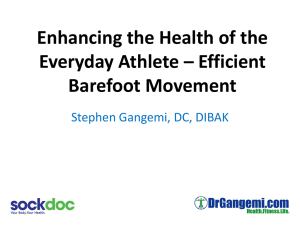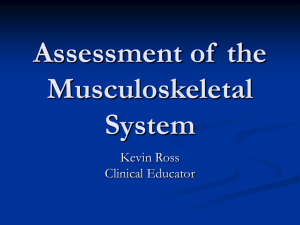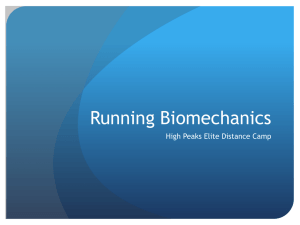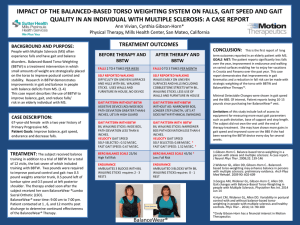Barefoot Running
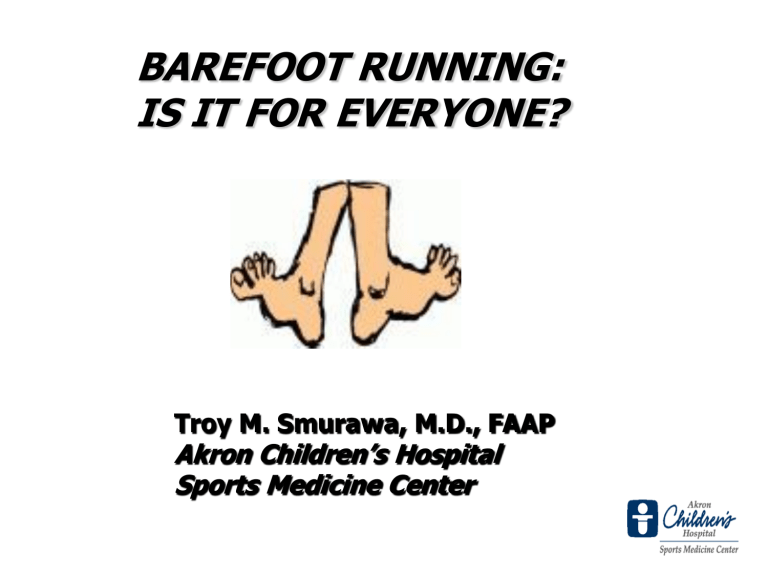
BAREFOOT RUNNING:
IS IT FOR EVERYONE?
Troy M. Smurawa, M.D., FAAP
Akron Children’s Hospital
Sports Medicine Center
Running Gait
Three Types of Gaits: o Walking Gait o Running Gait o Sprinting Gait
Walking Gait
Phase I: Heel-Strike
Phase II: Mid-Stance
Phase III: Toe-Off
Insert fig. 4-3
Walking Gait
Phase I: Heel-Strike
• Extended leg and foot are in front of the body mass
– Creates a braking and adapting effect before the next phase
• The foot is a loose adapter
– The ankle acts as a great adapter to all terrain
– The ankle can either pronate or supinate to adapt to the changing surface
Walking Gait
Phase II: Mid-Stance
• Upper body is centered over the midfoot and balanced with gravity
• The foot is stable and locked ready for the toe-off phase
Walking Gait
Phase III: Toe-Off
• The foot is in a levering and propulsive position
• The upper body mass is forward of the toeing-off foot
• The body is moving forward
Walking Gait
• A process of braking, adapting, locking, levering and propelling
• Very efficient gait with little impact forces
• The legs and hips lever the body very efficiently
• The foot is in contact with the ground for a long time with a large surface area contact
• Braking muscles and propulsive muscles are isolated
• With walking speeds impact forces are minimal
Running Gait
Phase I: Midfoot/Forefoot-Strike
Phase II: Mid-Stance
Phase III: Toe-Off
Insert fig. 4-4
Running Gait
Phase I: Midfoot/Forefoot-Strike
• land on midfoot/forefoot
• The ball of the foot first touches lightly to sense the surface
• The foot settles down to touch the ground lightly
Insert fig. 4-4
Running Gait
Phase II: Mid-Stance
• foot becomes parallel to the ground surface
• settling of the heels initiates elastic recoil
• upper body moves forward over center of mass
Insert fig. 4-4
Running Gait
Phase III: Toe-Off
• foot starts to lever
• a simple lift of foot off the ground occurs
Insert fig. 4-4
Sprinting Gait
Phase I: Forefoot-Strike
• land on forefoot
• The ball of the foot first touches lightly to sense the surface
Sprinting Gait
Phase II: Mid-Stance
• foot stays up on forefoot
• elastic recoil starts without the heels setting on ground
• upper body remains over and slightly forward of center of mass
Sprinting Gait
Phase III: Toe-Off
• foot immediately starts to lever
• a toe-lift of foot off the ground occurs
Heel-Strike Running Gait
Running with a heel-strike walking gait
• Results in overstriding
• Increases braking/impact and rotational forces
• Slower cadence secondary to extended time on ground from heelstrike and mid-stance phases
• Increased muscular forces needed to push off the ground to keep momentum and start a new stride
• Inefficient cycle in which you are always trying to catch up:
– planted foot is on the ground longer
– more difficult to increase cadence
– push off to start new stride
– more muscular force needed to start a new stride and keep momentum
– center of mass lags behind
– body is back in same position as on the previous stride
Evolution of the Running Shoe
Traditional Running Shoe Design
• Increased heel cushioning with a dense, soft elastic foam (EVA – ethylene vinyl acetate)
• Increased heel height with a steep heel to toe ramp angle
• Thick outsoles and built up arch support and pronation control
• Accommodates the heel-striking running gait
Evolution of the Running Shoe
Traditional Running Shoe Design
38 mm
14.7%
15 mm
Evolution of the Running Shoe
The shoes impact on running form
Body Position:
Level foot
balance point is midfoot and balanced with gravity
Elevated heel
recenter balance point under rearfoot
-hips tilt forward, low back arches
-upper body leans back
-forces a heel-strike gait
Elevated toe
balance point is forefoot
-hips tilt backward, low back pushes backward, upper body leans forward
Evolution of the Running Shoe
The traditional shoes impact on running form
• Encourages heel-striking gait and does not allow the heel to land naturally and parallel to the ground
• With heel-strike the foot is in the braking position, creates overstriding and slower cadence
• The whole body is unbalanced and unable to react quickly
• Soft foam midsole dampens sensory input with ground for proprioceptive response
• Elevated heel gets in the way and is the first part of the shoe to hit the ground
• Negates the elastic recoil of running gait by foot sinking into the cushion and dissipates energy laterally
Impact of Running Shoes on Kinematics
• Braking, Pushing and Bouncing
• Impact Rotational and Propulsive Forces
Impact of Running Shoes on Kinematics
• Braking, Pushing and Bouncing
• Heel-striking causes braking with the ground in front of the body mass
• With the body leaning backward counteracts forward motion
• Increased need for power to push-off hard and keep momentum forward
• Increases vertical oscillation ( bouncing up and down)
Impact of Running Shoes on Kinematics
• Impact Rotational and Propulsive Forces
1. Heel striking creates braking requiring increased push off forces
2. Shearing on lower back and spine
3. Excessive body rotation
4. Ankle becomes a loose (unstable) adaptor with ground
5. Overpronation and oversupination
6. Increased rotational forces at the joints
7. Increased vertical bounce
Impact of Running Shoes on Kinematics
• Impact Rotational and Propulsive Forces
Heel-Strike Running Gait
Natural Running Gait
• Running Efficiently and Economically
• What is Natural Running?
• Barefoot Running
• Common Running Form Mistakes
• Minimalist Running Shoes
Adapting Natural Running
• Is all about feet, form and whole body movement
• Running in a relaxed manner
• Having the awareness to touch the ground lightly and lift quickly on every stride
• Leads to more efficient running mechanics:
– Upright posture with a slight forward lean at the waist
– Compact arm swing
– Quick cadence with center of mass over midfoot
– Maintains forward momentum with each stride
• Results in less impact forces and fewer rotational forces on the foot and body
Natural Running Gait
• Quicker and higher stride cadence than walking
• A series of one-legged stances landing under the center of mass
• A new stride is started immediately after foot strike
• Upper body needs to remain upright with a slightly forward-leaning posture to maintain momentum
• Foot strikes under center of mass
• Upper body never lags behind
• Start new stride by lifting leg instead of pushing off
• Quicker cadence and less impact
• less rotational forces and less propulsive muscular forces
Natural Running Gait
• Minimizes vertical oscillations
Natural Running Gait
Barefoot Running
Barefoot Running
• Running unshod your foot naturally seeks out the ground by landing at the midfoot/forefoot
• Maximizes sensory feedback from your forefoot for proprioceptive responses to the ground
• Barefoot running allows a runner to:
1. Run with an upright posture and slight forward lean
2. Have a compact and consistent arm swing
3. Run with low-impact footsteps near the ball of your foot
4. Maintain a forward moving momentum
• Under controlled running environment and surfaces injuries can be minimized
• Lightweight shoes can allow your feet to mimic the flexibility and motion of barefoot running
Barefoot Running
Zola Budd
• http://www.youtube.com/watch?v=FGSjpUIGbZs
• http://www.youtube.com/watch?v=FGSjpUIGbZs&feature=related
Dr. Daniel Lieberman
Studied the impacts of barefoot running vs. shod running
found that habitually barefoot runners tend to land on their forefoot with less force and more efficiency when compared to shod runners whose cushioned shoes promote heel striking.
E:\Barefoot Running\Nature barefoot running.htm
Lieberman, D.E., M. Venkadesan, W.A., et. al.. “Fott Strike
Patterns and Collision Forces in Habitually Barefoot vs Shod runners. Nature. 2010 Jan 28; 463&7280):531-5
Barefoot Running
• Regular small doses can improve running mechanics and teach you to land lightly at your midfoot/forefoot
•
It can strengthen the muscles and fascia in your feet and ankles
• Allows you to use your muscles as suspension springs to dampen impact forces and propel forward with elastic recoil
• Enhances running efficiency by putting you in the proper running form and strengthening the muscles to execute these movements
• Not every barefoot runner lands on the forefoot/midfoot
• You do not need to be a barefoot runner to become a forefoot runner – improve posture, cadence and striking under your center of gravity
• Questionable whether barefoot running will enhance performance
Common Running Form Mistakes
• Braking Impact and Excessive Rotation
– Caused by running with a heel strike gait
– Causes abrupt braking of forward momentum - overstriding
– Leads to excessive rotation in feet, ankles, knees, legs and hips
• Excessive Muscular force
– Requires runner to use more force to create forward propulsion
– With every heel-strike in front of your center of mass your upper body pushes back behind your center of mass
• Both mistakes lead to excessive vertical oscillation, inefficiency and more impact, rotation and muscle tendon stress
Minimalist Running Shoes
Minimalist Running Shoes
• Allows your feet to mimic the flexibility and motion of barefoot running
• Has a level profile and firm material under the midfoot/forefoot
• Allows the natural settling of the heel after impact so the foot is parallel to the ground
• Enables the energy return of elastic recoil to begin the next stride
• Protects feet from unnatural surfaces and hazards on the ground
• Provides thermal properties to protect from hot pavement or frozen ground
Minimalist Running Shoes
28 mm
15 mm
Developing a Natural Running Form
• Dynamic Strengthening
• Forms Drills
• Barefoot running
• Repetition
Developing a Natural Running Form
Landing lightly under the body at midfoot/forefoot allows:
1. Properly sensing the ground to respond appropriately
2. Lock the ankle and eliminate excessive rotational forces
3. Eliminates braking forces and slower cadence
4. Diminishes the impact forces with the ground
5. Maintains an upright posture with a slight forward lean and compact arm swing creating forward propulsion and momentum
6. Placed in position to lift knee to begin a new stride
7. Eliminates the inefficent vertical oscillation
8. Run relaxed mentally and physically
Developing a natural running form
http://video.nytimes.com/video/2009/10/04/health/1
247464987589/barefoot-running.html
Is Barefoot Running for Everyone?
Not everyone may be able to run barefoot, but the principles of barefoot running can help a runner achieve a more efficient, economical and injury-free running form.
This can be achieved by adopting a natural running form through dynamic strengthening, form drills, barefoot running, minimalist shoes and repetition.
